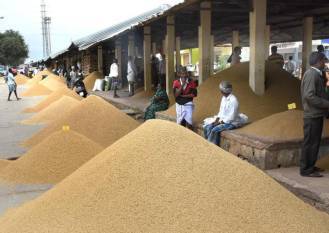NEW DELHI, 22 May 2024: Across the vast agricultural landscape of India, a network of bustling marketplaces pulsates with life - the mandis. These traditional markets, overseen by Agricultural Produce Market Committees (APMCs), play a pivotal role in connecting farmers with buyers, ensuring the smooth flow of agricultural produce.
This report delves into the heart of mandis, exploring the number of farmers utilizing them, the geographical distribution, trade volume, and the types of produce changing hands within these vital spaces.
Millions Rely on Mandis: The Scope of Farmer Participation
Mandis serve as the primary platform for a vast majority of Indian farmers to sell their produce. Estimates suggest that over 80% of farmers in India rely on mandis to sell their agricultural output. This translates to millions of farmers across the country, highlighting the critical role mandis play in their livelihoods.
A Geographical Mosaic: Distribution of Mandis Across States
The presence of mandis varies considerably across different states in India. Here's a breakdown of the distribution:
- States with the Highest Number of Mandis: Punjab, Haryana, Maharashtra, Karnataka, and Uttar Pradesh lead the way with a well-established network of mandis. These states are major agricultural producers, and the high number of mandis caters to the needs of a large farming population.
- States with Limited or No Mandis: The northeastern states, including Arunachal Pradesh, Mizoram, Nagaland, and Sikkim, have a lower number of mandis due to factors like hilly terrain and a focus on cash crops. Additionally, some union territories like Dadra and Nagar Haveli and Daman and Diu may not have dedicated mandis.
A Glimpse into Daily Transactions: Average Turnover at Mandis
The daily turnover at mandis can vary significantly depending on factors like location, seasonality, and the type of produce being traded. However, estimates suggest that the average daily turnover at a mandi in India could range from ₹1 lakh (USD 1,250) to ₹50 lakh (USD 6,250).
A Bounty of Produce: What's Traded in Mandis?
Mandis act as a marketplace for a diverse range of agricultural produce. Here's a glimpse into the types of commodities traded:
- Food Grains: Rice, wheat, pulses (dals), and millets are staple food grains that dominate trade in mandis across the country.
- Fruits and Vegetables: A vibrant section of mandis features a wide variety of seasonal and non-seasonal fruits and vegetables, catering to the dietary needs of a large population.
- Commercial Crops: Cotton, sugarcane, oilseeds (groundnut, mustard), and spices (turmeric, chili) are some of the key commercial crops traded in mandis, depending on the region's agricultural strengths.
- Livestock: In some mandis, dedicated sections cater to the buying and selling of livestock, including cattle, goats, and poultry.
The Challenges and the Road Ahead: Modernizing the Mandi System
While mandis play a crucial role in Indian agriculture, they face challenges:
- Infrastructure Issues: Many mandis lack proper storage facilities, leading to post-harvest losses. Upgrading infrastructure is essential.
- Market inefficiencies: The auction process can be slow and cumbersome, potentially leading to lower prices for farmers.
- Limited Transparency: Concerns exist about potential middlemen manipulating prices and exploiting farmers.
The government is taking steps to modernize the mandi system by:
- Promoting e-NAM (National Agriculture Market): This online platform aims to connect mandis across the country, facilitating greater transparency and price discovery.
- Strengthening APMCs: Efforts are underway to improve the functioning of APMCs to ensure fair trade practices.
- Focus on Farmer Producer Organizations (FPOs): Encouraging FPOs can empower farmers to collectively bargain for better prices and reduce dependence on middlemen.
Conclusion: A Future for Mandis
Mandis remain an integral part of the Indian agricultural landscape. By addressing the existing challenges and embracing modernization initiatives, mandis can continue to serve as a vital link between farmers and consumers. As India strives for a more robust and sustainable agricultural sector, mandis will need to evolve to meet the changing needs of farmers and a growing population. By ensuring greater efficiency, transparency, and fair trade practices, mandis can secure a vibrant future within the evolving agricultural ecosystem of India.
Image credit: thehindu.com























